TLR5
-
Official Full Name
toll-like receptor 5 -
Overview
This gene encodes a member of the toll-like receptor (TLR) family, which plays a fundamental role in pathogen recognition and activation of innate immune responses. These receptors recognize distinct pathogen-associated molecular patterns that are expressed on infectious agents. The protein encoded by this gene recognizes bacterial flagellin, the principal component of bacterial flagella and a virulence factor. The activation of this receptor mobilizes the nuclear factor NF-kappaB, which in turn activates a host of inflammatory-related target genes. Mutations in this gene have been associated with both resistance and susceptibility to systemic lupus erythematosus, and susceptibility to Legionnaire disease. -
Synonyms
TLR5;toll-like receptor 5;TIL3;SLEB1;FLJ10052;MGC126430;MGC126431;OTTHUMP00000036039;OTTHUMP00000036040;toll/interleukin-1 receptor-like protein 3;TLR 5;TLR5_HUMAN;Toll/interleukin 1 receptor like protein 3;TIL 3;Toll like receptor 5 precursor
Recombinant Proteins
- Mouse
- Human
- Rat
- Chicken
- Rhesus macaque
- CHO
- HEK293
- E.coli
- Mammalian Cells
- Wheat Germ
- Fc
- Non
- His
- S
- GST
- DDK
- Myc
- Avi
- Flag
Background
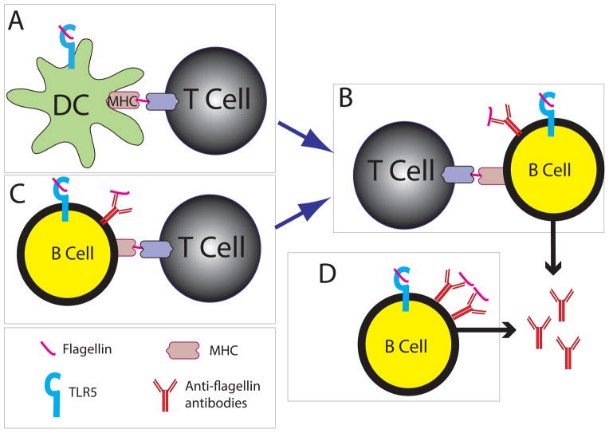
Fig1. Possible mechanisms for the production of anti-flagellin antibodies. (Cynthia A Leifer, 2014)
What is TLR5 protein?
TLR5 (toll like receptor 5) gene is a protein coding gene which situated on the long arm of chromosome 1 at locus 1q41. This gene encodes a member of the toll-like receptor (TLR) family, which plays a fundamental role in pathogen recognition and activation of innate immune responses. These receptors recognize distinct pathogen-associated molecular patterns that are expressed on infectious agents. The protein encoded by this gene recognizes bacterial flagellin, the principal component of bacterial flagella and a virulence factor. The activation of this receptor mobilizes the nuclear factor NF-kappaB, which in turn activates a host of inflammatory-related target genes. The TLR5 protein is consisted of 858 amino acids and its molecular mass is approximately 97.8 kDa.
What is the function of TLR5 protein?
TLR5 is a pattern recognition receptor that plays an important role in the body's natural immune system. It activates the host's defense mechanisms primarily by recognizing the flagellin of bacteria. Activation of TLR5 can initiate signaling pathways, particularly through the MyD88-dependent pathway, leading to the activation of transcription factors such as NF-κB, which promotes the expression and release of inflammatory cytokines such as TNF-α and IL-6. In addition, TLR5 also participates in the expression of antimicrobial peptides, directly participates in antibacterial response, promotes dendritic cell maturation and antigen presentation, and activates adaptive immune response. TLR5 activity is also associated with regulating the function of regulatory T cells (TREGs), affecting their proliferation and immunosuppressive activity.
TLR5 Related Signaling Pathway
When TLR5 recognizes flagellin, it activates downstream signaling via myeloid differentiation factor 88 (MyD88), leading to the activation of NF-κB transcription factor, which promotes the expression of genes associated with inflammatory response. The signaling pathway activated by TLR5 leads to the production of inflammatory cytokines, such as tumor necrosis factor α (TNF-α), interleukin 6 (IL-6), etc., which are involved in inflammation and immune responses. TLR5 signaling can promote dendritic cell maturation and antigen presentation, activate T cells and B cells, and thus initiate adaptive immune responses. The activation of TLR5 can regulate the proliferation and immunosuppressive function of Treg cells, and affect immune homeostasis and tolerance.
TLR5 Related Diseases
TLR5 (Toll-like receptor 5) is associated with the occurrence and development of many diseases, especially its role in inflammatory response and tumor development has attracted increasing attention. Flagellin recognized by TLR5 plays a key role in intestinal mucosal immune regulation, and its abnormal expression may be associated with inflammatory bowel disease (IBD) and other intestinal diseases. In addition, the activation or inhibition of TLR5 may affect the immune escape mechanism of tumor cells, which is related to the occurrence and development of tumors such as breast cancer. Loss-of-function mutations in TLR5 are common in humans and may be associated with the development of sporadic breast cancer. In oropharyngeal squamous cell carcinoma (OPSCC), TLR5 expression levels correlate with patient prognosis. The activation of TLR5 signaling pathway can also promote the occurrence of anti-tumor immunity. Therefore, the TLR5 agonist Entolimod has become a research hotspot due to its anti-tumor potential.
Bioapplications of TLR5
As a key receptor in the innate immune system, TLR5 stimulates the occurrence of anti-tumor immunity by initiating innate immune response and adaptive T cell immunity. Its agonist Entolimod has become a focus of research due to its anti-tumor potential. As a natural immune agonist, flagellin, ligand of TLR5, can activate innate immunity and stimulate adaptive immune response, providing a new idea for tumor immunotherapy. The TLR5 agonist CBLB502 (Entolimod) is used as an adjuvant in radiation therapy to reduce radiation-induced damage, protect normal tissue, and enhance the effect of radiation therapy.
Case Study
Case Study 1: Nicole Tegtmeyer, 2020
Helicobacter pylori (Hp) is an important human pathogen associated with gastric inflammation and neoplasia. It is commonly believed that this bacterium avoids major immune recognition by Toll-like receptors (TLRs) because of low intrinsic activity of its flagellin and lipopolysaccharides (LPS). In particular, TLR5 specifically detects flagellins in various bacterial pathogens, while Hp evolved mutations in flagellin to evade detection through TLR5. Cancerogenic Hp strains encode a type IV secretion system (T4SS). The T4SS core component and pilus-associated protein CagY, a large VirB10 ortholog, drives effector molecule translocation. Here, the researchers identify CagY as a flagellin-independent TLR5 agonist. They detect five TLR5 interaction sites, promoting binding of CagY-positive Hp to TLR5-expressing cells, TLR5 stimulation, and intracellular signal transduction.
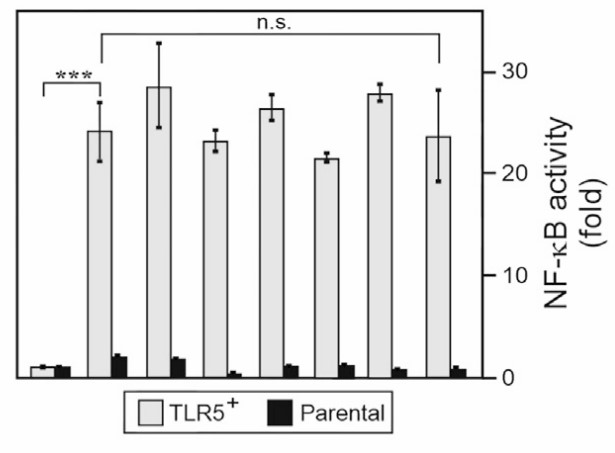
Fig1. Activation of TLR5 in HEK reporter cells was quantified using NF-κB luciferase reporter gene assays.
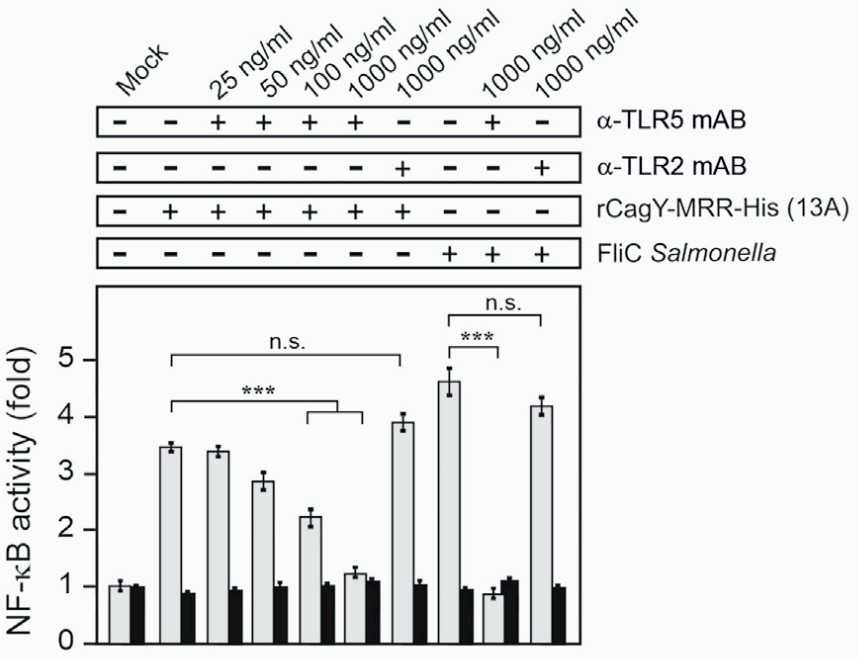
Fig2. Specific blocking of NF-κB stimulation in TLR5 reporter cells by recombinant Hp CagY and Salmonella FliC (20 nM each) in the presence of α-hTLR5 neutralizing antibodies.
Case Study 2: Tong Shi, 2017
CBLB502 derived from Salmonella flagellin is a novel agonist of Toll-like receptor 5 (TLR5). It has been shown that CBLB502 can exert high radioprotective efficacy on mice and primates from both GI and hematopoietic syndromes during whole-body irradiation with low toxicity and immunogenicity. However, no effective system has been used to investigate the protective effect of CBLB502 against irradiation and the related mechanism in vitro. This study investigated the radioprotective properties of CBLB502 in HEK293-N-T cells constitutively expressing human TLR5 and NF-κB-dependent luciferase. HEK293-N-T cells were treated with different doses of CBLB502 prior to 60Co-γ ray irradiation. After irradiation, cell viability was real-time measured for 4 days by using the real-time cell analysis system. They found that CBLB502 was capable of efficiently maintaining the survival rate of irradiated HEK293-N-T cells. Then apoptotic cell death and cell cycle were detected by flow cytometry.
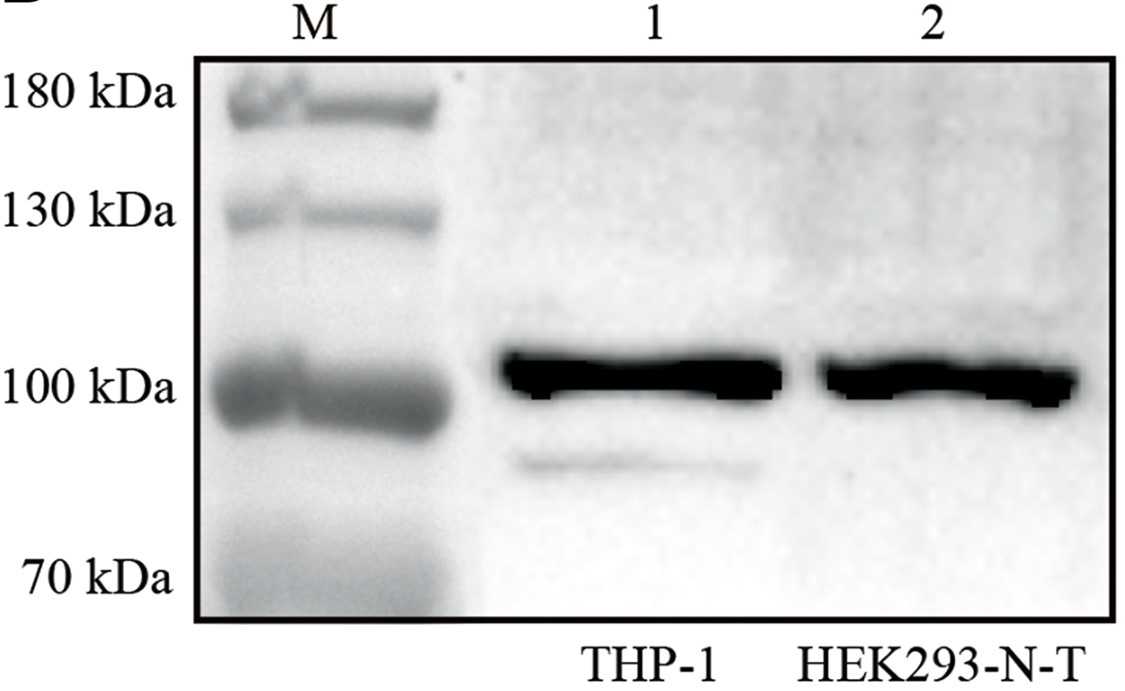
Fig3. Western blot analysis of the expression of hTLR5 in HEK293-N-T cells.
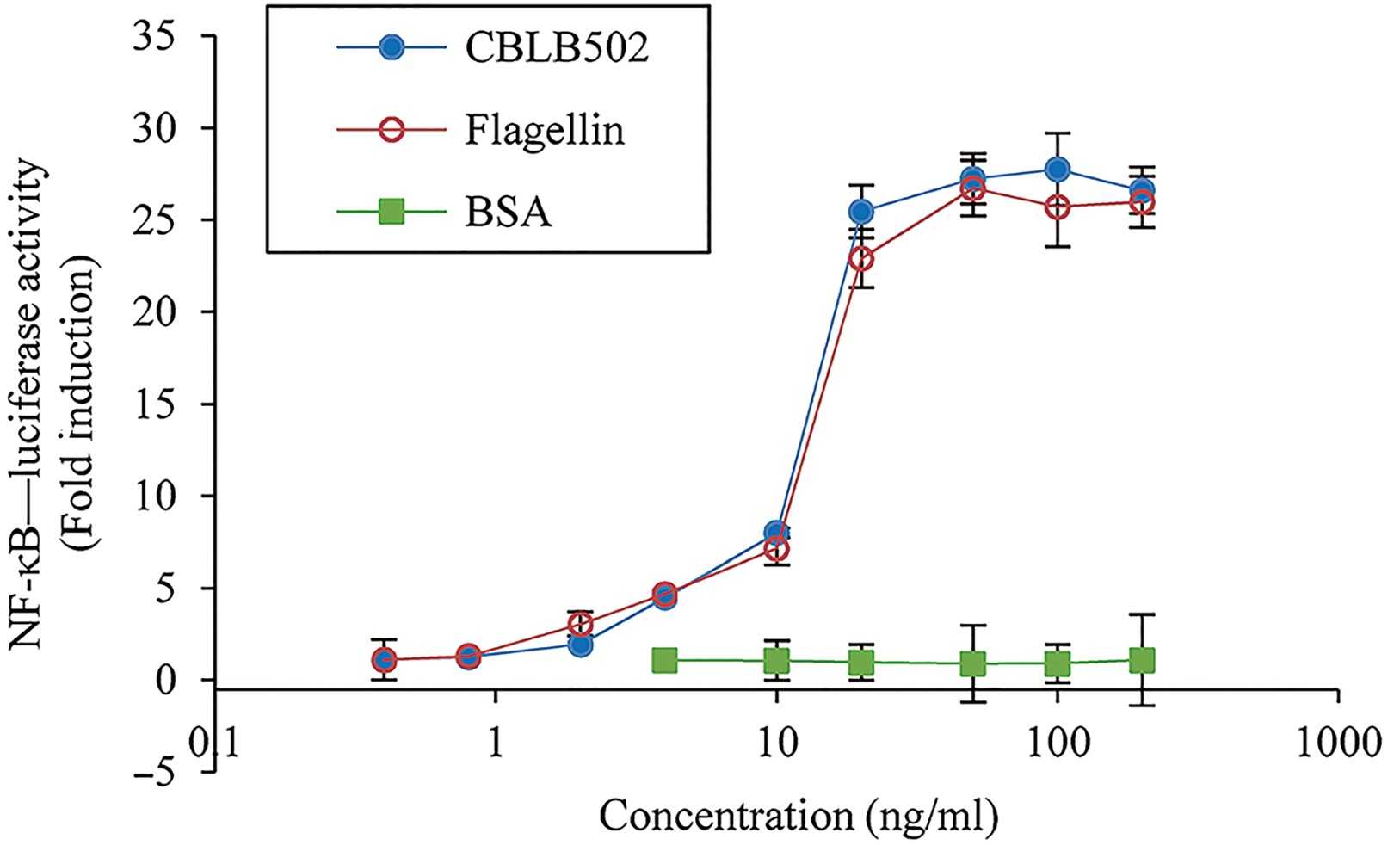
Fig4. Luciferase assays to determine the effect of CBLB502 on the activation of NF-κB signaling pathway.
Quality Guarantee
Involved Pathway
TLR5 involved in several pathways and played different roles in them. We selected most pathways TLR5 participated on our site, such as Toll-like receptor signaling pathway,Pathogenic Escherichia coli infection,Salmonella infection, which may be useful for your reference. Also, other proteins which involved in the same pathway with TLR5 were listed below. Creative BioMart supplied nearly all the proteins listed, you can search them on our site.
| Pathway Name | Pathway Related Protein |
|---|---|
| Inflammatory bowel disease (IBD) | HLA-DQA1,HLA-DPB1,IL1A,FOXP3,HLA-DOB,STAT4,IL18RAP,HLA-DQA2,Il23a; Il12b,HLA-DQB1 |
| Salmonella infection | IL6,ARPC5B,PKN1,CXCL8B.3,KLC1,RHOG,RAC1A,CCL3L3,PFN3,TLR5B |
| Toll-like receptor signaling pathway | MAPK14A,NFKBIA,TLR1LB,TLR4BA,TBK1,MAPK1,MAP2K6,Ifna11,MAPK9,TNF |
| Pathogenic Escherichia coli infection | TUBB7P,TUBA3E,CD14,TUBA1A,ARHGEF2,TUBA4A,OCLN,LY96,NCK2,EZR |
| Legionellosis | BNIP3,NAIP6,CASP9,CYCS,CLK1,Casp3,CASP8,CXCL2,APAF1,HBS1L |
Protein Function
TLR5 has several biochemical functions, for example, interleukin-1 receptor binding,transmembrane signaling receptor activity. Some of the functions are cooperated with other proteins, some of the functions could acted by TLR5 itself. We selected most functions TLR5 had, and list some proteins which have the same functions with TLR5. You can find most of the proteins on our site.
| Function | Related Protein |
|---|---|
| transmembrane signaling receptor activity | LEPR,Cd79a,FCGR2C,DCC,PTH1RA,AGER,KLRC1,P2RX6,GP6,CD247 |
| interleukin-1 receptor binding | IL1A,IL36RN,IL36G,TRIP6,Il1f6,IL1RAP,IL36A,IL1B,IL37,IL36B |
Interacting Protein
TLR5 has direct interactions with proteins and molecules. Those interactions were detected by several methods such as yeast two hybrid, co-IP, pull-down and so on. We selected proteins and molecules interacted with TLR5 here. Most of them are supplied by our site. Hope this information will be useful for your research of TLR5.
PAUF;MYD88
Resources
Research Area
Related Services
Related Products
References
- Nishi, H; Maeda, N; et al. Differential regulation of epidermal growth factor receptor by hydrogen peroxide and flagellin in cultured lung alveolar epithelial cells. EUROPEAN JOURNAL OF PHARMACOLOGY 748:133-142(2015).
- Lockner, JW; Eubanks, LM; et al. Flagellin as Carrier and Adjuvant in Cocaine Vaccine Development. MOLECULAR PHARMACEUTICS 12:653-662(2015).
Reviews
I was very impressed with the breadth of your product offerings, and will certainly check back for future needs. - Customer from @wistar.org


.jpg)
.jpg)
